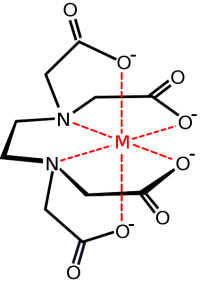Difference between revisions of "EDTA"
From Genetics Wiki
| Line 4: | Line 4: | ||
Locks up metal ions in solution which inactivates enzymes (such as nucleases) that depend on these metal ions to function. | Locks up metal ions in solution which inactivates enzymes (such as nucleases) that depend on these metal ions to function. | ||
| + | |||
| + | =Safety= | ||
| + | *[[HMIS#Health|Health 1]] | ||
| + | *[[HMIS#Flammability|Flammability 1]] | ||
| + | *[[HMIS#Physical Hazard|Physical Hazard 0]] | ||
| + | *[[HMIS#Personal Protection|Personal Protection E]] | ||
| + | |||
| + | Brief note: Low risk. Skin and eye irritant. May be combustible. LD50: 30 mg/kg (Mouse) | ||
| + | |||
| + | [[MSDS]]: http://www.sciencelab.com/msds.php?msdsId=9927166 | ||
=Links= | =Links= | ||
Revision as of 03:57, 28 July 2018
Ethylenediaminetetraacetic acid (EDTA) (disodium salt dihydrate)
Locks up metal ions in solution which inactivates enzymes (such as nucleases) that depend on these metal ions to function.
Safety
Brief note: Low risk. Skin and eye irritant. May be combustible. LD50: 30 mg/kg (Mouse)
MSDS: http://www.sciencelab.com/msds.php?msdsId=9927166
Links
https://en.wikipedia.org/wiki/Ethylenediaminetetraacetic_acid
What Links Here
- TAE (← links)
- Sample Collection (← links)
